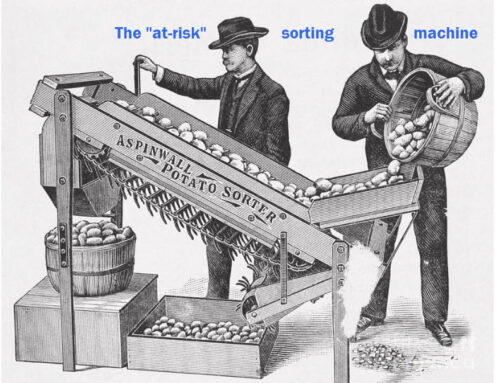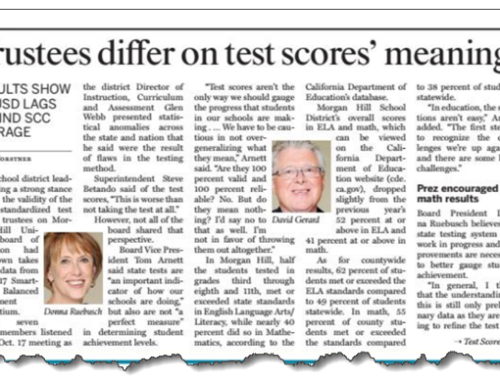What has happened to the high hopes policy heavies had for Local Control Accountability Plans? After reading dozens of districts’ plans, and after working side by side with district LCAP planning teams in three counties, I suspect those high hopes have for the most part remain unmet. Have those hopes all been dashed? I don’t think so. But with a new round of LCAPs having been approved last summer by nearly a thousand school boards, perhaps it’s time to stand back and take stock.
My encounters with just four dozen plans leaves me with anecdotal impressions. More solid observations can be found in the September 2018 report by Julia Koppich and Daniel Humphrey, “The Local Control Funding Formula (LCFF): What Have We Learned After Four Years of Implementation?” It’s one of the many reports that are part of the bushel basket of research papers, Getting Down To Facts II. It’s part of a four-year research project by six researchers called the LCFF Research Collaborative. They’ve interviewed over 500 people, written 30 case studies, and produced six papers prior to this one. But this new paper is centered on about 80 interviews that included districts and county offices of education, parents and leaders, school and district people.
This is not a research paper aimed solely at academics and policy people. It is also for the rest of us humble mortals, those who do the work of running schools and districts, and those who are farther down the tower of power. It is also a readable recap of the warning signs offered by those whose interviews formed the raw material for this research. I urge you to give it a look. And let me tempt you with a practical reason for reading it. If you know what rocky shoals other ships have crashed upon, you will be far more likely to navigate your ship’s course safely.
“The vast majority of superintendents who sought help (83%) reported their greatest need for support was to complete technical aspects of the LCAP template. More than half (58%) reported they needed more assistance than they received…. Nearly two-thirds of superintendents (62%) who sought support for measuring their district’s progress toward meeting their LCAPs said they did not receive enough help in this area.”
To read the LCAP portion of the report, start on page 39. The following six pages are just about the LCAP. If you also read to page 51, you’ll also read about the strain on county office staff, and the new dynamic of district-county office relations.
Let me also tempt you with a few selected warning signs, and for the sake of balance, a few encouraging signs of opportunity, that may ring familiar.
Selected warning signs in the report
- Compliance thinking. This infectious disorder has spread widely through the K12 ecosystem. Only the younger leaders seem to be less likely to carry the disease. One superintendent in interview with Julia Koppich put it well: “We have a whole generation of ed services administrators who have been geared, programmed, and fine tuned to do one thing—be in compliance. They are compliance thinkers.” (Koppich et.al., 2015)
- Excessive complexity. Sure, plans are complicated, especially when plans span three years, and try to estimate the degree of progress that should result from the spending of a discrete amount of resources on a particular group of students. So the LCAP takes staff too long to build it, and too long to write it. The result now runs over 120 pages for most districts.
- Unreadable. The Getting Down to Facts report, in blunt language, points to the opacity of the LCAP: “The resulting document is too long, too confusing, and all but unreadable for even the most sophisticated educators, let alone parents and community members.”
- Too many purposes. Here’s what the report says: “Since its inception, the LCAP has presented districts with challenges determining the purpose the template is meant to serve. Guidance from the state has indicated the LCAP should be used for: (1) stakeholder engagement, (2) planning and budgeting, and, (3) accountability. Yet many districts have found encapsulating all three in a single document to be both confusing and overwhelming.”
Selected signs of encouragement
- Districts want help. The heavy lifting required to plan calls for district staff to work outside their zones of comfort and competence. The report summarizes their survey of superintendents’ views of their need for help: “The vast majority of superintendents who sought help (83%) reported their greatest need for support was to complete technical aspects of the LCAP template. More than half (58%) reported they needed more assistance than they received…. Nearly two-thirds of superintendents (62%) who sought support for measuring their district’s progress toward meeting their LCAPs said they did not receive enough help in this area.”
- County offices want help. County superintendents surveyed were candid about their limited capacity to help district LCAP teams. “Just above two-thirds of survey respondents believe COEs should develop their capacity to provide assistance in all areas relevant to LCFF implementation.” And another startling admission about lack of capacity is from a 2017 report from the same research team: “Just seven percent of COE superintendents say they “already had the necessary systems and personnel in place to support implementation of LCFF in the county” (PACE, 2017).
I should add that this matches my experience in the field. The best news is that many districts and CoEs are taking planning seriously, and want help meeting a higher standard for reports that are effective. The not-so-good news is that many have also surrendered to the compliance cloud that hangs so heavily over California. The bureaucratic perpetuation of these compliance habits-of-mind needs to stop.
In a follow-up blog, I’ll share my thoughts on how to do that, and point to some people who are doing it well. (A self-interest declaration is warranted. My company, School Wise Press, has a K12 Measures team that provides technical analysis and professional development to district and school planning teams, and to county office teams guiding continuous improvement.) Hang on. There’s more to come.






